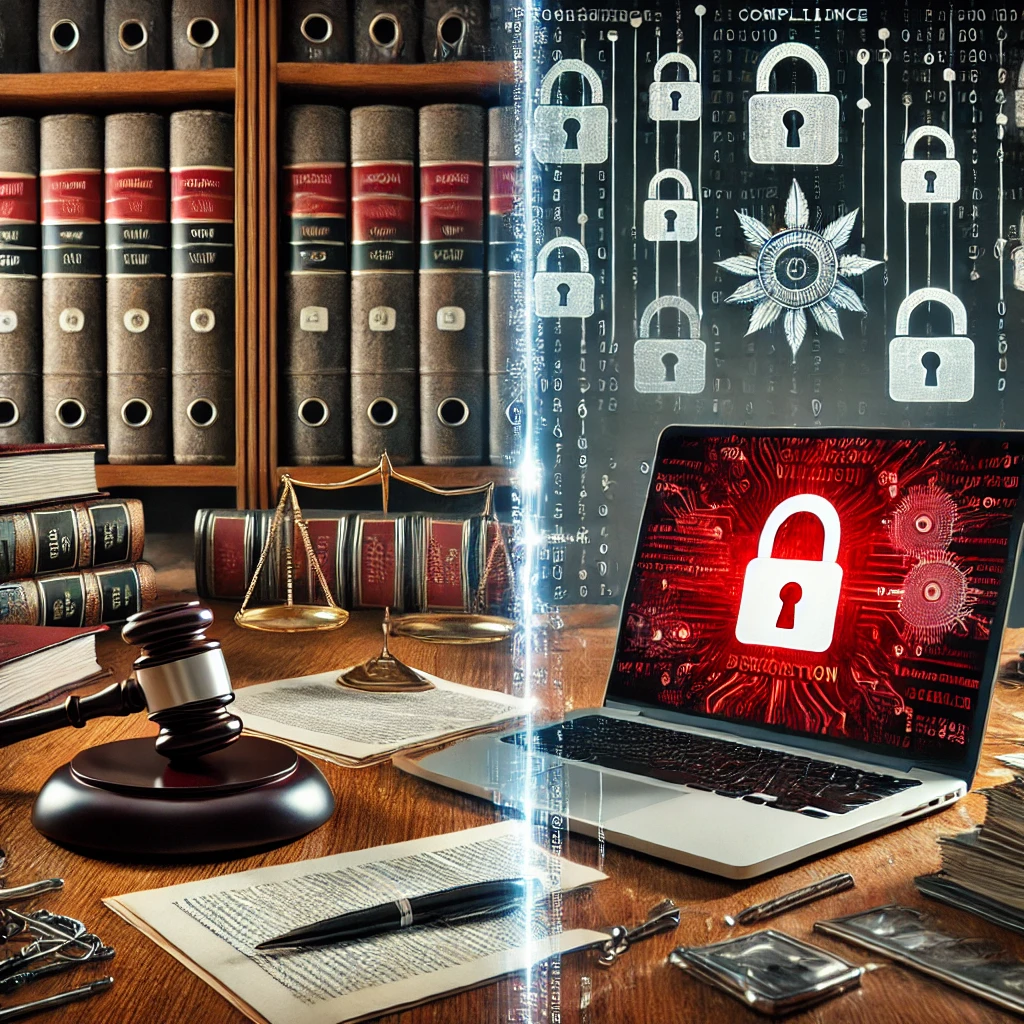Legal Compliance After a Ransomware Attack
Recognizing the Threat: Understanding the Risks of Ransomware on Compliance
Legal compliance after ransomware attacks is a critical concern for businesses. At Alvaka, we understand how these attacks can compromise not only your data security but also your ability to meet regulatory requirements. Ransomware, a type of malware that encrypts data and demands payment for its release, can lead to significant compliance issues, particularly where sensitive customer information is concerned. The threat of non-compliance grows as cybercriminals become more sophisticated, targeting industries with stringent regulatory obligations such as healthcare, finance, and retail.
The Immediate Aftermath: Steps to Take Following a Ransomware Attack
When faced with a ransomware attack, the immediate priority is to contain the breach and assess the impact on compliance. We advise clients to follow a structured response plan that includes isolating affected systems, securing backups, and initiating a thorough investigation. Rapid action is key to minimizing the damage and ensuring that compliance requirements are still fulfilled. It’s crucial to determine which data has been affected and to what extent, as this will influence the legal requirements for reporting the incident.
Legal Requirements: Key Compliance Laws and Regulations Affected by Ransomware
Understanding the patchwork of compliance laws and regulations is paramount in the aftermath of a ransomware attack. There are a myriad of rules including the Health Insurance Portability and Accountability Act (HIPAA), the General Data Protection Regulation (GDPR), and the California Consumer Privacy Act (CCPA), each with its own notification timelines and requirements in the event of a data breach. Non-compliance can result in hefty fines and damage to reputation. We at Alvaka are dedicated to guiding our clients through this complex landscape, ensuring they meet all legal obligations following a ransomware event.
Legal Compliance After Ransomware: Navigating Reporting Obligations
In the aftermath of a ransomware attack, we understand the critical importance of navigating legal compliance promptly and efficiently. At Alvaka, we assess the scope of the breach to determine the reporting obligations under relevant laws and regulations. Complying with these obligations is not just a legal formality; it’s integral to rebuilding trust and maintaining integrity within the affected networks and systems. Remember, regular communication with law enforcement and regulatory bodies is not only a requirement but also a strategic step in the responsible handling of such incidents.
Assessing the Damage: How to Conduct a Compliance Audit Post-Ransomware
Following a ransomware attack, conducting a thorough compliance audit is crucial. At Alvaka, we commence by methodically identifying the data and systems that were compromised, understanding the nature of the breach, and evaluating potential compliance impacts. This involves meticulously reviewing all digital evidence, logs, and access records to ensure that no stone is left unturned. Consequently, we develop a comprehensive report that details the extent of the damage and outlines the measures needed to address any compliance deficits. It is essential to act swiftly to avoid compounding the regulatory repercussions of the attack.
Developing a Remediation and Notification Plan
Devising a comprehensive remediation and notification plan is a critical step in ensuring legal compliance after ransomware. At Alvaka, our seasoned team takes the lead in creating a tailored response that not only addresses the immediate threats but also fortifies systems against future risks. This plan encompasses:
- Technical remediation to eradicate ransomware and reinforce systems.
- Notification procedures to alert stakeholders and regulatory bodies as required by law.
- Continuous monitoring to swiftly detect and respond to any residual or new threats.
As we execute the remediation and notification plan, our focus remains on transparent communication with all stakeholders, providing them with the assurance that we are restoring operations securely and in full compliance with legal mandates.
Did you know? After a ransomware attack, companies must quickly audit their compliance with relevant laws like the GDPR or HIPAA, as these often require timely breach notifications to authorities and affected individuals.
Reassessing Your Security Posture: Lessons Learned from Ensuring Legal Compliance after Ransomware
At Alvaka, we believe that reassessing your security posture is not merely a onetime fix, but an evolving strategy integral to upholding legal compliance after a ransomware incident. We take the hard lessons learned from these disruptive events and turn them into robust, proactive measures. By meticulously analyzing how the breach occurred and which safeguards were bypassed, we are able to refine our security controls, ensuring we not only meet but exceed industry standards. This prudent approach caters to both immediate recovery and long-term resilience, aiming to shield your business from the legal ramifications of future threats.
Maintaining Transparency with Stakeholders: The Role of Communication in Compliance
In the wake of a ransomware attack, it is our duty to maintain clear and consistent communication with all stakeholders. The ramifications of such an incident extend beyond our internal operations, often affecting clients, investors, and partners who entrust us with their data. We believe in being transparent about the situation, what steps we’re undertaking for ransomware recovery, and how we’re bolstering our defenses. Our forthright approach solidifies trust and demonstrates our unwavering commitment to legal compliance after ransomware, even in the most challenging circumstances.
Future Proofing: Strategies to Prevent Non-Compliance Following Future Attacks
Future proofing against ransomware is an indispensable component of our service offering. Our strategies encompass comprehensive employee training, regular software updates, advanced threat detection, and incident response planning. By staying ahead of evolving cyber threats, we help ensure that your business is not only recovering from the present challenge but is also being fortified against future risks. Our aim is to continuously adapt and enhance our protective measures to uphold the strictest standards of legal compliance after ransomware.
FAQ
What immediate actions should we take following a ransomware attack? ▼
After a ransomware attack, it is crucial to first contain the breach to prevent further encryption of data by disconnecting infected systems from the network. Subsequently, it’s imperative to assess the extent of the damage and engage with cybersecurity professionals to investigate the incident. Furthermore, we must notify law enforcement and check if there are any specific legal reporting obligations we need to comply with.
How does ransomware impact our compliance with data protection laws? ▼
Ransomware can significantly impact compliance, as it often involves unauthorized access to sensitive data. Consequently, we may be in violation of laws like the GDPR or HIPAA if personal or health information is compromised. We must thoroughly assess the breach and report it to relevant authorities within the mandated timeframes to maintain compliance.
What is a compliance audit and how do we conduct one post-ransomware? ▼
A compliance audit is a comprehensive review of our organization’s adherence to regulatory standards. After a ransomware attack, it involves examining the affected systems and processes to determine if there were any compliance lapses. We should engage with internal or external auditors to systematically review our controls, procedures, and documentation to ensure we return to a state of compliance.
Are we required to report a ransomware attack to authorities or affected individuals? ▼
Yes, in many cases, reporting a ransomware attack to authorities is mandated by law. Furthermore, if the compromised data includes personal or health information, we must also notify the affected individuals. The specific requirements can vary based on the jurisdiction and the nature of the data involved.
How do we develop a remediation plan following a ransomware attack? ▼
To develop a remediation plan, we must first identify the vulnerabilities that were exploited and then rectify them to prevent future breaches. Afterward, it is essential to upgrade our security measures, improve staff training, and revise policies and procedures. This plan should be comprehensive, addressing technical, operational, and compliance-related improvements.
What should be included in our notification plan to stakeholders after a ransomware incident? ▼
Our notification plan should clearly articulate the nature and scope of the breach, the measures taken to address it, and how we plan to protect affected individuals. Moreover, it needs to include a timeline for communication and identify the stakeholders who will require updates, such as customers, partners, and regulators.
How do we reassess and improve our security posture after ensuring legal compliance? ▼
Once we’ve ensured legal compliance, it is imperative to conduct a thorough review of our security posture, which includes risk assessments, penetration testing, and security audits. Moreover, we should consider investing in advanced threat detection and response technologies. Continuously monitoring for new threats and adjusting our security strategies accordingly is vital to maintaining a robust defense.
Why is communication important in maintaining compliance following a ransomware attack? ▼
Effective communication is indispensable for maintaining transparency with stakeholders and rebuilding trust. Additionally, it ensures that all parties are informed about the actions being taken to rectify the situation and prevent future incidents. Transparent communication can also help fulfill reporting obligations to regulatory agencies.
What strategies can we implement to avoid non-compliance after future attacks? ▼
To avoid non-compliance, we should implement layered security strategies such as regular backups, multi-factor authentication, employee training programs, and incident response planning. Furthermore, staying abreast of legal changes and regularly revising our compliance framework to match evolving threats and regulations is essential.
Can we be held liable for the non-compliance caused by a ransomware attack? ▼
Yes, organizations can be held liable for non-compliance if it’s demonstrated that we failed to take appropriate security measures to prevent such an attack. Hence, establishing and maintaining a comprehensive cybersecurity and compliance program is critical for both prevention and mitigating legal risks.







